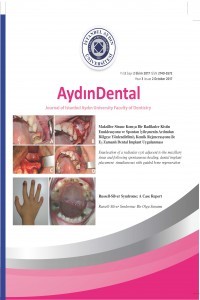Geleneksel ve Yeni Nesil Akışkan Kompozit Rezinlerin Farklı Adeziv Sistemler ile Dentine
Mikrogerilim Bağlanma Dayanımlarının Değerlendirilmesi
Amaç: Bu çalışmanın amacı, geleneksel ve yeni nesil iki akışkan kompozit rezinin üç farklı adeziv sistem ile dentine bağlanma dayanımı üzerine etkisini mikrogerilim bağlanma dayanımı test yöntemi ile değerlendirmektir.Gereç ve Yöntem: Kırk iki adet çürüksüz insan üçüncü büyük azı dişin okluzal minesi kesilerek okluzal dentin açığa çıkarıldı. Dentin yüzeyleri, 600-grid silikon karbid kâğıtla (SIC) zımparalandı. Dişlerden rastgele altı grup oluşturuldu (n=7). Grup 1-Clearfil S3Bond+ Clearfil Majesty Flow, Grup 2-Clearfil SE Bond+Clearfil Majesty Flow, Grup 3-Prime&Bond NT +Clearfil Majesty Flow, Grup 4-Clearfil S3Bond+ReFil SDR Flow, Grup 5-Clearfil SE Bond+ReFil SDR Flow, Grup 6-Prime&Bond NT+ReFil SDR Flow. Restore edilen dişler, 1mm2’lik çubuklar elde edilecek şekilde kesildi. Her bir çubuk, dakikada 1 mm hızla hareket eden cihazla mikrogerilme testine tabi tutuldu. Sonuçların karşılaştırılmasında tek-yönlü ANOVA, t ve Tamhane testleri kullanıldı.Bulgular: Clearfil Majesty Flow gruplarında Clearfil SE Bond daha yüksek mikrogerilim bağlanma dayanımı göstermiştir (p< 0.05). ReFil SDR Flow grubunda ise, Clearfil SE Bond ve Clearfil S3Bond’un mikrogerilim bağlanma dayanım değerlerinin, Prime&Bond NT’ye göre yüksek olduğu bulunurken (p<0.05), kendi aralarında bir fark bulunamadığı belirlenmiştir (p>0.05). Bununla birlikte, Clearfil Majesty Flow ve ReFil SDR Flow gruplarındaki adezivlerin mikrogerilim bağlanma dayanım değerlerinin karşılaştırılmasında yalnızca Clearfil S3Bond için iki grup arasında istatistiksel olarak anlamlı bir farklılık gösterdiği tespit edilmiştir (p<0.05).Sonuç: Bu in vitro çalışma koşullarında, adezivlerin dentine bağlanma dayanımı üzerinde farklı etkilere neden olabileceği görüldü
Evaluation of Microtensile Bond Strength of Conventional and New Generation Flowable Composite Resins to Dentın Wıth Different Adhesive Systems
Objective: The purpose of this study was to evaluate the effect of conventional and new generation two flowable composite resins with three different adhesive systems on bond strenght to dentin by using the microtensile bond test.Material and Method: Fourty two non-carious human third molars were sectioned parallel to the occlusal plane to expose occlusal dentin. The dentin surfaces were ground with 600-grid silicon carbide (SIC) paper. Teeth were randomly divided in to six groups (n=7). Group 1-Clearfil S3Bond+ Clearfil Majesty Flow, Group 2-Clearfil SE Bond+Clearfil Majesty Flow, Group 3-Prime&Bond NT +Clearfil Majesty Flow, Group 4-Clearfil S3Bond+ReFil SDR Flow, Gorup 5-Clearfil SE Bond+ReFil SDR Flow, Group 6-Prime&Bond NT+ReFil SDR Flow. The restored teeth were serially sectioned to obtain 1mm2 sticks. Each stick was submitted to the microtensile test performed at a crosshead speed of 1mm/minute. One-way ANOVA, and Tamhane’s tests were used to compare the data.Results:The results indicated that Clearfil SE Bond showed higher microtensile bond strength when compared to the other adhesives in Clearfil Majesty Flow group (p< 0.05). Clearfil SE Bondand Clearfil S3Bond showed similar microtensile bond strength (p>0.05) whereas microtensile bond strength of Prime&Bond NT was significantly decreased (p<0.05). However, in the comparision of the microtensile bond strength values of Clearfil Majesty Flow and ReFil SDR Flow groups adhesive, it was determined a statistically significant difference between two groups for the only Clearfil S3Bond (p<0.05).Conclusion: In the experimental conditions of this study it was seen that adhesive systems may have different effects on the bond strenght to dentine tissue
___
- Can Say E, Nakajima M, Senawongse P, Soyman M, Tagami J. Microtensile bond strength of a filled vs unfilled adhesive to dentin using self-etch and total-etch technique. J Dent 2006; 34: 283-29.
- as an array. J Dent Res 1998; 77:205 (Abstr. No.798). [15]
- Terada RSS, Carvalho RM, Fernandes CAO, Pashley DH. Mapping bond strength to flat
- Tanaka J, Ishikawa K, Yatani H, Yamashita A, Suzuki K. Correlation of dentin bond
- Altun C. Kompozit dolgu materyallerinde son gelişmeler. Gülhane tıp dergisi 2005; 47(1): 77-82.
